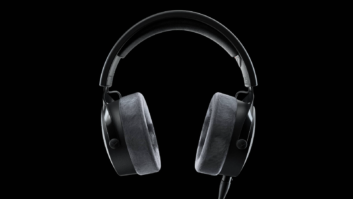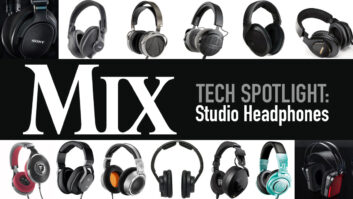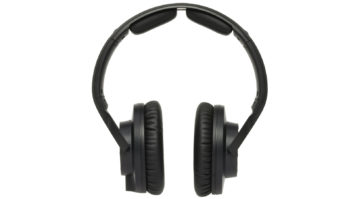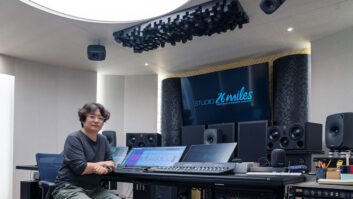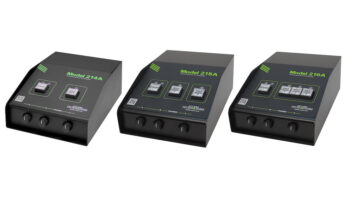
Headphones are the ultimate “near-field” monitors. Like our ears (and heads), they come in every shape, size and type, each serving a specific purpose and price range.
All electro-mechanical transducers — microphones, monitors and headphones — are position-sensitive. We know how a microphone can “favor” one vocalist or instrument over another, and that mic and monitor placement can be a major, if not critical, sound-shaping factor. The first goal of a well-designed pair of headphones is mechanical: The amount of consistency with which the drivers can be positioned over the ears optimizes imaging and detail; ear pad design and headband tightness affect bass response.
Maximizing your headphone experience starts with picking the ones you like best, but it doesn’t end there. For example, the amplifiers used to drive our “cans” also contribute to the sonic experience. And for the voice-over artist or vocalist, the ability to reverse polarity (phase) is a simple, technical option that can have a great sonic impact. The sound arriving at the ears via ‘phones should be the same polarity as the sound conducted through the body.
At a micro-acoustic level, the design and choice of materials should maximize frequency response and minimize distortion and resonance. It’s no wonder, then, that manufacturers are periodically tweaking their designs and offering model variations. It is also no surprise that some headphone enthusiasts latch on to certain models, even after they’ve been discontinued.
Real World
Many factors, both subjective and objective, are part of selecting headphones, so I talked to a few engineers to find out what determines their choice. Those I interviewed emphasized accuracy and truth for themselves, but chose flattering and inspiring (aka “hyped”) for musicians. At least two engineers, Ryan Hewitt and Tom Hambleton, expressed their affection for the discontinued Sennheiser HD580 ‘phones, preferring them over their successor, the HD-600s, which the engineers describe as being a bit more “hyped.”
Hambleton’s personal faves are the Denon AH D-2000s; he describes them as being “tight, with good bass, nice mids, sweet highs and not fatiguing” and good enough to get balances on — high praise, indeed. Hewitt’s preferred studio cans are the Sony MDR-7506s, which he says are “super-hyped and exciting.”
Engineer Chuck Zwicky, described the Fostex T50RPs as sounding like a ribbon microphone. “They took more than a minute to get used to, are not flattering or hyped,” but once the user becomes acclimated, Zwicky says, “they reveal things that nothing else will.”
Mike Zirkel (Smart Studios, Madison, Wisc.) uses Grado headphones during the mixing process, but prefers Fostex T40 headphones in the studio because they can take abuse and are easily serviced. He also recommends GK Music Ultraphones for drummers because of their high isolation and familiar sound. That headphone company, owned by jazz percussionist Gordy Knudtson, integrates the Sony 7506 driver into a sealed environment for ultimate isolation.
Bringing Specs Into Focus
A referral from a friend, in simple descriptive words, can mean more to an engineer than a list of specs, especially if a well-known headphone is used as reference. If all manufacturers provided standardized information and a frequency-response chart, we’d be able to correlate between a familiar headphones, like the Sony MDR-7506s, and unfamiliar cans vis á vis their graphics. This might not be a perfect solution, but it would be a good start, especially when so many of us shop online. We could learn from the response charts and other data about the “typical” range or windows: shy-of-the-mark at one end, “accurate” in the middle and “hyped” at the other.
Headphone frequency response is not flat. The ear is a complex device, and frequency response alone — without a decibel tolerance (+/- x dB) — is just bandwidth. Similarly, low distortion at 1 kHz is an easy feat as compared to the challenge of achieving low distortion in the bass region. Some manufacturers provide minimal to no specifications, save for a few choice marketing superlatives, while other manufacturers, like Beyer, provide a standards reference such as IEC 60268-7. (At minimum, this makes it easier for European broadcasters to do comparative shopping.)
Impedance is another squirrelly specification because of the way it relates in both directions: how well the headphone driver (speaker) couples to the ear and the relationship between an amplifier and the headphone driver. We all know how bass response can be optimized by headphone position and a snug fit. Similarly, low amplifier source impedance can reduce the “hyped bumps” at the bass and treble extremities.
Headphones have a wide impedance range, and most headphone amplifiers include a resistor in series with the output jack — this determines the “source” impedance. The value is not consistently implemented; it’s chosen as much to protect the drivers as well as reduce noise, but the ability to tweak this value would be a great option. (A 32-ohm resistor in series with a 32-ohm driver will attenuate the signal and the noise by 6 dB.) Rather than randomly plugging into any old headphone jack, you can expect more consistent results by using the same headphone amplifier.
Minneapolis-based mastering engineer Greg Reierson uses the Creek OBH-11 — a stand-alone headphone amplifier — with his vintage pair of Sony MDR-V6s. He also checks mixes on stock iPod earbuds, which he feels are very close to being an in-ear “standard,” considering the number of people who listen that way. On that subject, Etymotic Research (www.etymotic.com) does not make “headphones,” but does make all sorts of hearing-related paraphernalia, from high-fidelity earplugs and hearing aids to improved ear buds for the iPod. Few audiologists relate to the needs of recording engineers, but the Etymotic site is an exception worth browsing for insights into how hearing works (including technical papers).
Under the Muffs
Bottom line: Headphones are tools. We’d all like our favorites to be robust — to tolerate physical and electrical abuse — and be comfortable. Headphones have become very specialized: DJ ‘phones can handle 3.5 watts, while headphones for drummers can provide up to 35 dB of isolation. It’s a plus if they can fold up — transformer style — into a compact footprint. In the greenest sense, making fewer, better-sounding headphones that last longer and can be repaired makes the most sense.
If you’re looking to purchase new headphones, the chart above, featuring open and closed models, will help you get started. At best, it provides common specs at a glance, such as power handling and impedance. It also shows how inconsistently specs are reported (efficiency, for example), or worse, not reported at all. For the most part, “street/net” prices are quoted. And if you already have a great-sounding pair of fragile headphones (or vice versa), let us know by e-mailing [email protected]. We’ll publish the results online.
Mix contributing editor Eddie Ciletti writes the monthly “Tech’s Files” column.
Know Your Headphone Specs
Definitions of Commonly Used Terms
Open Design: Features an open grille on the back of the ear cup, exposing the driver to the outside and allowing free propagation of sound waves. Offers less isolation and less distortion.
Closed Design: Features a sealed backing, which attenuates sound waves propagating away from the ear. Provides better isolation, but is sometimes said to distort at certain frequencies due to resonances.
Circumaural: Cushion/ear pad goes around (outside) the ear.
Supra-Aural: Cushion/ear pad sits on top of the ear.
IEC 318: An artificial ear specification for a device that loads the sound source (headphone) with a mechanical impedance that approximates the typical human ear. A calibrated microphone is used within the device for measurement purposes.
IEC 60268-7: Standardizes the designation and description of headphones; lists characteristics to be specified, with the relevant methods of measurement.
Efficiency: The sound pressure for a given amount of voltage (dB/V) or power (dB/mW).

